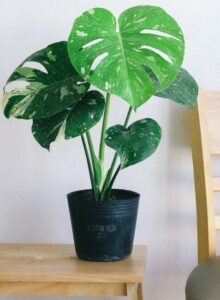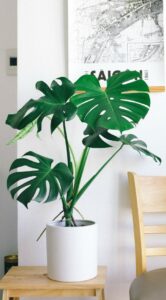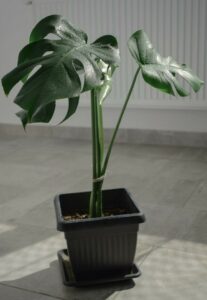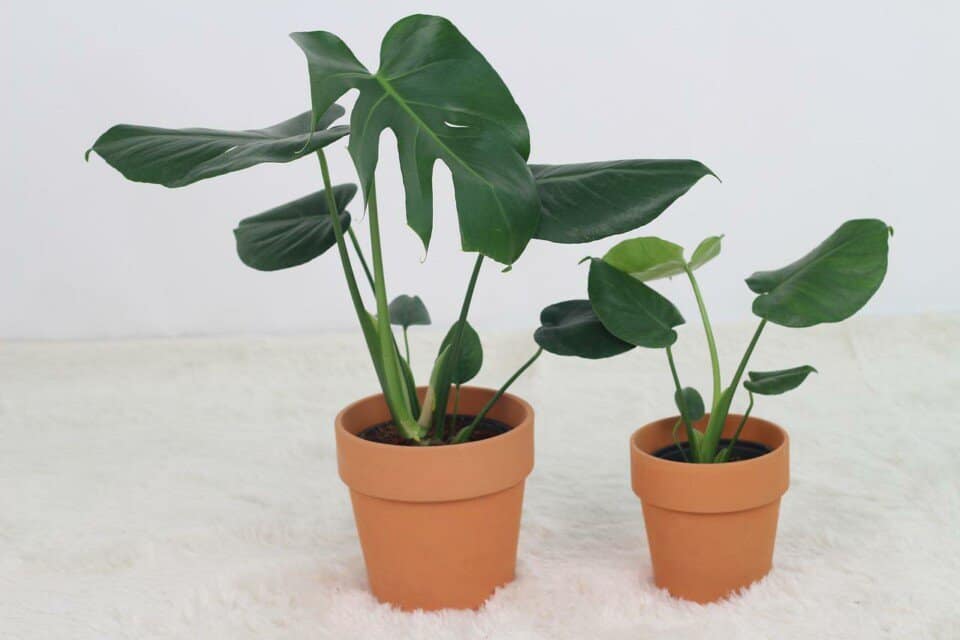Some links in the post are affiliate links and I get a commission from purchases made through some links found in the post.
Since I started growing plants, I have learned a lot about them. It turns out that they all appreciate balance – not too much and not too little.
And this holds especially true when it comes to watering. Plants that are underwatered often suffer stunted growth with weak foliage, and the overwatered ones often yellow and rot.
Overwatering is usually the worse culprit as it paves the way for root rot, also known as the silent killer.
This fungus creeps up on your plant and attacks it from the base such that by the time you notice yellowing and drooping in your plant, it is likely on the verge of dying.
So, am I telling you this to shock or scare you? Not at all! In the past, I thought altering my watering schedule was all it took to maintain a healthy moisture balance for my plants.
But I have learned that it is a trifactor – your watering schedule, the kind of soil you use, and the type of pot you use. In this guide, I will focus on how to choose the right pot for your monstera.
The pot you use does not fall under a one-size-fits-all umbrella but instead comes down to specific factors as covered below:
Considerations When Deciding What Pot to Get for Your Monstera
The considerations when deciding what pot to get for your monstera are:
Does the pot have drainage?
How big is the pot?
What décor do you have going on?
Where will you position the pot?
Do you have an overwatering history?
What material does the pot have?
It’s easy for someone to point at one pot and declare it a good fit for your monstera. But is it? Regardless of the monstera species you have in your home, you must focus on the following critical factors.
1) Does the Pot have Drainage?
 Monsteras are neither water-loving nor drought resistant. And that means you must have them in well-draining potting soil.
Monsteras are neither water-loving nor drought resistant. And that means you must have them in well-draining potting soil.
However, the well-draining aspect of the soil would not help much if the pot did not have drainage holes.
After all, all the excess water that the soil did not take up would end up taking up the air spaces. And that would be a catalyst for root rot and other fungal diseases. Eventually, you would notice issues such as:
- Drooping of the plant and the leaves,
- Mold on the soil surface, and
- Yellowing leaves.
The soil can even start smelling foul, among other adverse changes. Thus, when selecting a pot for your monstera, ensure it has drainage holes sufficient for the size of the pot.
The good thing about drainage holes is that you can create them if the pot does not have enough. However, given the risk of damaging the pot when doing so, you can always consider getting a pot that already has existing holes.
2) How Big is the Pot?
Monstera parents know that monsteras grow fast and often need repotting every two to three years in most cases. But does that mean you should reach for the biggest pot you can find in the home improvement store?
Not quite. You must always consider the size of the monstera and buy a pot with that in mind. Below are the rules of thumb:
- If growing a new monstera from a cutting, you should start with a 6-inch pot. The monstera will likely outgrow the pot the following year, but it is always good to start small and build from there.
- If you are repotting a monstera because you dislike its current pot type, you should check if the plant is rootbound. If it hasn’t reached that stage, you can use a pot of a similar size because the focus here is on the pot material.
- If you are repotting a monstera that has outgrown its current pot, you should use a container two to three inches wider than the current one. That will allow the plant to spread its roots but still contain them to avoid proliferated root growth.
Why does pot size matter so much? You may be looking at this and wondering why you can’t just pick the pot size that looks good to you. It comes down to the environment created by your pot size.
A big pot allows the potting soil to collect more water than the monstera will use. Moreover, it also increases the risk of overwatering.
And these factors put your plant at risk of developing root rot. Additionally, when you place the monstera in a pot too big for it, the plant focuses on expanding its root system.
As a result, foliage production suffers. And we all know that the monstera shines because of its foliage, so that would only hurt its aesthetic.
How about a small pot? We can agree that big pots are bad news. But how about smaller ones? A slightly rootbound monstera will be fine as it can still access nutrients and water, albeit at a smaller scale.
However, the more its roots become rootbound, the less access it will have to nutrients and water. Eventually, the plant suffers stunted growth and starts browning on its leaf tips and edges.
If you do not act on time, the plant starts dropping its leaves and could die.
Thus, you must find the right pot size, two to three inches bigger than the current one.
3) What Décor do you Have Going On?
 I know! How did I fit this into the guide? But before you write it off, think about it. Anything you invite into your home plays a vital role in the overall look of the space.
I know! How did I fit this into the guide? But before you write it off, think about it. Anything you invite into your home plays a vital role in the overall look of the space.
For example, if you are working with a minimalistic design, you must look for items whose elements match this vibe.
And while this will not necessarily affect how well your plant does in the space, it will play a part in how well it blends into the space. Thus, it is worth a thought.
On this note, also look for a pot that complements the beauty of the monstera. Some pots are so busy that you can end up overshadowing the unique features of the plant.
But again, this is a matter of preference, and you can as well skip this entire section without killing your plant.
4) Where Will you Position the Pot?
While many pots work fine indoors and outdoors, not all can work outdoors. Moreover, not all of them can be in the direct sun. You must thus consider the kind of environment your monstera needs and how this would impact the pot.
Moreover, think about the heft of the pot. If you are keen on rotating your monstera every week or so, getting a light pot works in your favor.
You can avoid lagging too much weight around and damaging your floors during the rotation. But if your monstera will remain put in the given location, you can use a heavy pot.
It might not be the first thing that comes to your mind. But when you need to get some work done around the pot, you will realize how crucial it is.
This point also ties in with the first one, i.e., a pot positioned in a high-traffic area will likely need to be moved often. And you would thus need a light one.
5) Do you Have an Overwatering History?
I often recommend moisture meters to gardeners as they help you gauge how much water your potting soil has.
And this way, you can avoid overwatering the soil and creating an ideal environment for root rot and other fungal diseases. And while this works, you can take an additional step by using a pot that has your back.
What does this mean?
If you often water your plants or have a history of overwatering, getting a porous pot is in your best interests. Such a pot wicks away moisture so that the soil will likely be dry the next time you water the plant.
But a non-porous pot would hold on to the excess moisture, which would spell trouble for your monstera.
The reverse also holds. People with an underwatering issue are better off with non-porous pots as these can provide the plant with moisture for longer.
And that way, the monstera would not suffer neglect for too long.
While your choice of pot will not replace a sound watering regimen, it will take the bulk of the work off your shoulders.
6) What Material does the Pot Have?
I’ll admit that as a newbie plant parent, I often focused on the aesthetic of the pots rather than their benefits to the plants.
I later realized that while a pot may be breathtakingly perfect for my patio, it may not work for my plant.
That said, let’s cover the three most common materials available for monsteras and how each of them would impact your plant.
a) Terracotta Pots
 Many people choose terracotta pots for their monsteras as they work indoors and outdoors. Moreover, they boast the following benefits:
Many people choose terracotta pots for their monsteras as they work indoors and outdoors. Moreover, they boast the following benefits:
- They are porous such that they wick away extra moisture and air, allowing the potting soil to remain dry. That makes it easier for you to avoid overwatering the plant.
- They are cool because of their thick walls and thus have excellent insulation properties. It makes it easier to leave the monstera outside on cool and hot days without it suffering adverse effects. I would recommend such pots for people who grow their plants outdoors, where the weather can sometimes be extreme.
- They are sturdy owing to their hefty and bulky builds. And that makes them excellent to offer your monstera support even on windy and rainy days. This factor is beneficial when you have a large monstera that requires additional support and has a moss pole supporting its growth.
- They make moisture management easier by showing you the water level on the pot. The porous nature of these pots acts in your favor as you can see how wet the pot is by checking its exterior. The pot becomes darker in the regions with water and is light in areas devoid of moisture.
Even with all these perks, these pots are still cost-effective as they come at friendly prices, and you can recycle them when done using them.
However, they have some disadvantages, which you should also consider. Which are these? Terracotta pots are pretty fragile; if you knock them over, they can break.
You must thus keep them out of reach of pets and children and avoid placing them at high points where they can fall over.
Also, while the wicking away of moisture may force you to water your monstera more often to keep up with the water loss rate.
b) Glazed Ceramic Pots
If porosity works against your watering habits, you can consider these pots. They are made of clay which would generally be porous.
But to stop the water and air wicking in their tracks, manufacturers add a layer of glaze that helps the pots retain water. Why would such pots work for your monstera?
- They are beautiful: I earlier mentioned that the general aesthetic of your home could influence your decision for a monstera pot. And with these pots, you will have an array of aesthetics to work with, which can complement the overall look of your space.
- They are heavy, increasing their stability and reducing their chances of falling over.
- They do not wick away moisture and are thus suitable for people who tend to neglect their monsteras.
Additionally, they boast the other benefits you would get from terracotta pots, save for the ones that have anything to do with wicking away moisture and air.
And because of their lack of porosity, these pots are not ideal for people who often overwater their monsteras. If you fall into this group, you can go with the terracotta option or drill more holes into your pot.
c) Plastic Pots
Plastic pots now feature designs that look like glazed ceramic or terracotta pots. But this is not the only reason monstera parents favor this pot material. What makes it such a good choice for plant parents globally?
- They are safe for monsteras. When people think of plastic, they often think of chemicals and wonder if these will affect their plants. But that’s not the case. Most manufacturers use safe plastic materials that will not affect your monstera adversely.
- They come in a wide range of options: Whether you are in the market for a luxurious type of pot or want a simple one, you can always find a suitable pot for your monstera. The same goes for colors, patterns, and other aspects that could influence your purchase choice.
- They are light, which makes it easy to move them around. Plus, they are flexible, and you can easily drop them without breaking them (don’t try it, though).
With recent technological advances, some of the plastic pots you find will be recyclable, and you can thus save the environment.
Of course, you must be ready to deal with non-porosity and lack of insulation when dealing with plastic pots.
3 Of the Best Pots for A Monstera
Ready to get some pots for your monstera? Below are some excellent options:
1) Plastic Planter Pots
These lightweight pots, available in different colors and designs, feature a simple look and have a drainage hole mesh to fit your saucer.
Additionally, they come in a set of three, allowing you to have options when repotting your monstera.
2) Terracotta Pots with Saucer
These breathable pots with drain holes and mesh covers come in neutral and warm colors that complement any space.
They dry out fast and are the ideal pots for people who want to steer clear of any more overwatering incidents.
3) Fopamtri Ceramic Planters
These ceramic pots feature a hollow bottom that allows them to easily drain excess water, making up for the lack of porosity.
Moreover, they come in an array of sizes and colors.
Any of these pots would be a good fit for your monstera, the factors above considered.
Do Monsteras Like Terracotta Pots?
Terracotta pots are ideal for monsteras owing to their heft, porosity, insulation properties, affordability, and sturdiness.
They work for all types of monsteras and can support your monstera indoors and outdoors. It would help if you were careful placing them as they can easily break when falling over.
Also, they are likely to develop mold owing to their porosity, and you should thus look out for such growth.
Do Monstera Plants Need Deep Pots?
You will notice that I did not mention much about depth when reviewing the best pot for your monstera. That’s because it does not matter so much.
Generally, your monstera should be fine if you get a pot that can accommodate its roots, leaving just a bit of room in the pot.
Only leave about an inch of space on each side of the pot, and the plant will be fine. A deep pot would only push the plant to produce more roots, taking precedence over foliage growth.
Should I Repot My Monstera After Buying?
 I would not recommend repotting the monstera after purchasing it. It would help if you allowed it to grow in the said pot until it shows signs of being rootbound. However, there are exceptions to this rule:
I would not recommend repotting the monstera after purchasing it. It would help if you allowed it to grow in the said pot until it shows signs of being rootbound. However, there are exceptions to this rule:
- When the current pot is not suitable for the growth of the plant, and
- If the plant is more than slightly rootbound.
If none of the above factors are in play, you can leave the monstera as it is.
Final Thoughts
Terracotta pots are generally best for your monstera. However, the aspect of what is best for your plant is highly subjective, and you are best poised to make that decision.
Happy Gardening!





